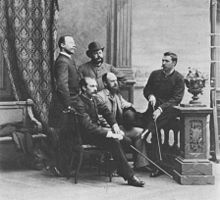Ernst Josephson
| Naissance | |
|---|---|
| Décès |
(à 55 ans)
Stockholm |
| Sépulture |
Mosaic Cemetery, Northern Cemetery (d)
|
| Nationalité | |
| Formation | |
| Activités | |
| Père |
Ferdinand Semy Josephson (d)
|
| Fratrie |
| Personne liée | |
|---|---|
| Genre artistique |
Ernst Josephson (né le à Stockholm (Suède), décédé le ) est un peintre suédois.
Biographie
Il a fait ses études d'art en Italie, en France et aux Pays-Bas, entre autres, et aurait dit à l'âge de 20 ans : « Je deviendrai le Rembrandt de Suède ou je mourrai ».

En 1884, il publie deux articles dans le journal suédois Dagens Nyheter sur ce que doivent être l'art et son enseignement, ces articles s'opposent aux méthodes de l'académie des Beaux-Arts de Stockholm[1]. En 1885 et 1886, il est un des meneurs du groupe d'artistes suédois installés à Paris à l'origine de la Konstnärsförbundet ("Fédération des artistes"), une organisation créée en 1886 en opposition à l'académie des Beaux-Arts de Stockholm[2].
Cependant, sa vie est marquée par la maladie. Il contracte la syphilis à un âge relativement jeune. En 1888, lors d'un séjours en Bretagne en compagnie d'Allan Österlind, il devient malade mental, ayant des hallucinations religieuses et croyant qu'il est Dieu et Christ .
Plus tard, il est hospitalisé à Uppsala et est diagnostiqué schizophrène, mais il continue à travailler tout au long de sa maladie, souvent dans un état de transe .
Il écrit également de la poésie, dans les collections Svarta rosor (1888, Roses noires) et Gula rosor (1896, Roses jaunes). Son œuvre principale, Näcken (1884, le Nix), est refusée par le Musée national suédois à Stockholm ; cependant, le prince Eugén, duc de Närke, achète cette peinture.
Le tableau de Josephson Strömkarlen montre la forte influence qu'il a sur la culture actuelle des peintres figuratifs scandinaves, notamment le norvégien Odd Nerdrum .
Galerie
-
Le receveur des postes à Bréhat
Notes et références
- (sv)Georg Nordensvan, Svensk Konst och Svenska Konstnärer i nittonde århundradet. 2. Från Karl XV till sekelslutet, Stockholm, Bonnier, 1928, p. 251. Ernst Josephson, "Om Den Konstnärliga Uppfostran i Stockholm", Dagens Nyheter, n° 6062 (B), 29 novembre 1884. Ernst Josephson, "Annu Ett Ord om den konstnärliga uppfostran i Stockholm", Dagens Nyheter, n° 6071 (B), 10 décembre 1884.
- (sv)Georg Nordensvan, Svensk Konst och Svenska Konstnärer i nittonde århundradet. 2. Från Karl XV till sekelslutet, Stockholm, Bonnier, 1928, p. 244-263.
Bibliographie
- Georg Nordensvan, Svensk Konst och Svenska Konstnärer i nittonde århundradet. 2. Från Karl XV till sekelslutet, Stockholm, Bonnier, 1928, p. 265-272.
- Michelle Facos, “A Controversy in Late Nineteenth Century Swedish Painting: Ernst Josephson’s The Water Sprite,” Zeitschrift für Kunstgeschichte (Fall 1993) vol. 56, no. 1: 61-78
- Michelle Facos, Nationalism and the Nordic Imagination. Swedish Art of the 1890s. University of California Press (1998)
- "Josephson, Ernst". Ett Binds Leksikon (3 e éd.). 1990
- Vibeke Röstorp, Le Mythe du retour. Les Artistes scandinaves en France de 1889 à 1908, Stockholm, Stockholms universitet, 2013.
- Wikipedia en suédois, article Ernst Josephson
Liens externes
- Waldemarsudde Museum
-
Notices d'autorité :
- Fichier d’autorité international virtuel
- International Standard Name Identifier
- Bibliothèque nationale de France (données)
- Système universitaire de documentation
- Bibliothèque du Congrès
- Gemeinsame Normdatei
- Bibliothèque royale des Pays-Bas
- Bibliothèque nationale d’Israël
- Bibliothèque universitaire de Pologne
- Bibliothèque nationale de Suède
- Réseau des bibliothèques de Suisse occidentale
- Bibliothèque apostolique vaticane
- Bibliothèque nationale d’Australie
- Base de bibliothèque norvégienne
- Bibliothèque nationale tchèque
- Bibliothèque nationale d’Argentine
- WorldCat Id
- WorldCat
-
Ressources relatives aux beaux-arts :
- Galerie nationale de Finlande
- Musée d'Orsay
- (de + en) Artists of the World Online
- (en) Bénézit
- (en) Grove Art Online
- (da + en) Kunstindeks Danmark
- (en + sv) Nationalmuseum
- (en + nl) RKDartists
- (en) Union List of Artist Names
Médias utilisés sur cette page
Photo ca 1885 with the leader of the Opponent movement (a group that wanted to change the Swedish Art Academy). Standing from left: Carl Larsson och Ernst Josephsson. Sitting from left: Richard Bergh, August Hagborg, Per Hasselberg.
In 1881 Ernst Josephson travelled to Spain accompanied by the painters Anders Zorn, Hugo Birger and Christian Skredsvig. Their aim was to see the works of the great Spanish masters in the museums and to depict Spanish peasant life. Ernst Josephson’s Spanish Smiths was painted in Triana, the area of Seville dominated by the Romani. The artist has himself described how the smiths asked if he could portray them standing outside their smithy. A later version of the work can be seen in the National Gallery in Oslo.
Picture of Ernst Josephson's grave at Judiska norra begravningsplatsen in Solna
Axel Borg has placed Ernst Josephson in front of The Water Sprite, a scene Josephson worked on intensely for years in many different versions.
Despite the exceedingly informal style, Louise Breslau’s portrait of Ernst Josephson nevertheless resembles a role portrait. With his hat and carelessly tied cravat and the spirit glass standing in front of him, he appears to epitomise the Paris bohemian. The portrait is dated 1886 and may have been executed during a visit to the Swedish artist colleague Allan Österlind, who also lived in France and was a friend of Louise Breslau.
Gåslisa
























